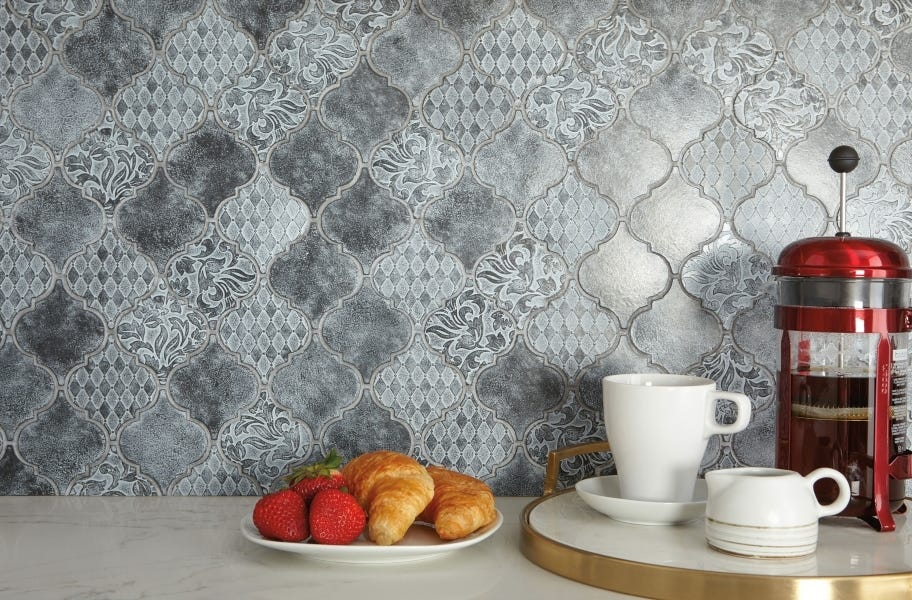
Backsplash tile is functional, attractive, and durable, and it can easily boost home value and upgrade your style. There are a ton of options when it comes to materials, shapes, patterns, and looks.
While having more choices is always a good thing, it can also be overwhelming. To help you on your journey to find the perfect backsplash tile, this guide is here to answer all of your big questions.
Get ready to learn about the different types of backsplash tile, the trendiest styles, how to install it, and a whole lot more!
What is Backsplash and Mosaic Tile?
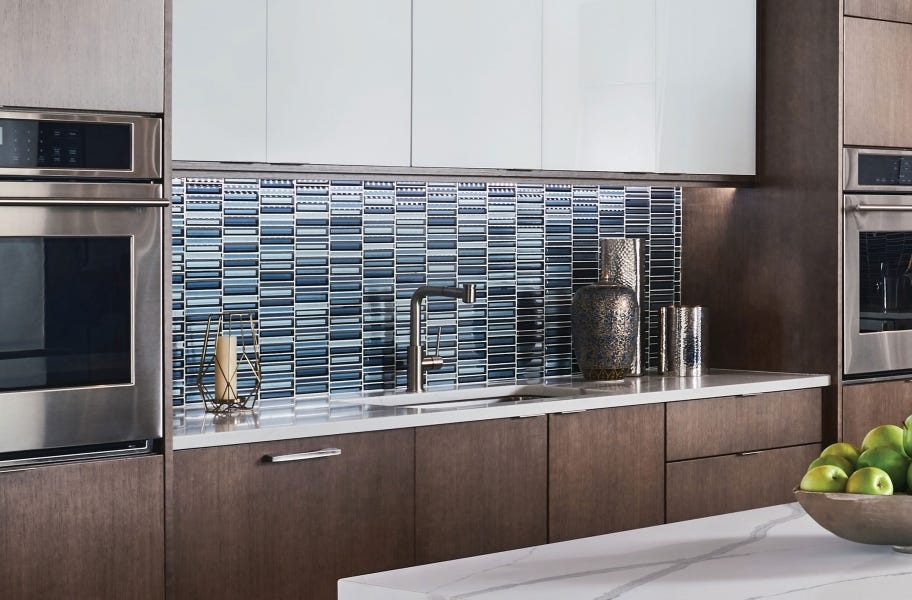
Backsplash tile is a mosaic wall tile designed primarily for kitchens and bathrooms. The backsplash typically covers a short area of the wall behind sinks and stoves, covering and protecting the wall where splashing and staining could occur. However, some homeowners are now installing full mosaic tile walls up to the ceiling for even more coverage, and for appearance.
The backsplash offers stylish looks as well as protection, as any DIY renovator can attest. It is often the focal point of your bathroom or kitchen, and you can completely transform the look of a space by installing some trendy wall tile there.
Best of all, these tiles are easy to install. They come in preassembled sheets for quick and easy installation. All in all, there’s a lot to love, and a lot to learn. So let’s get started!
| Related Content >> Wall Tile Buying Guide |
Types of Backsplash Tile
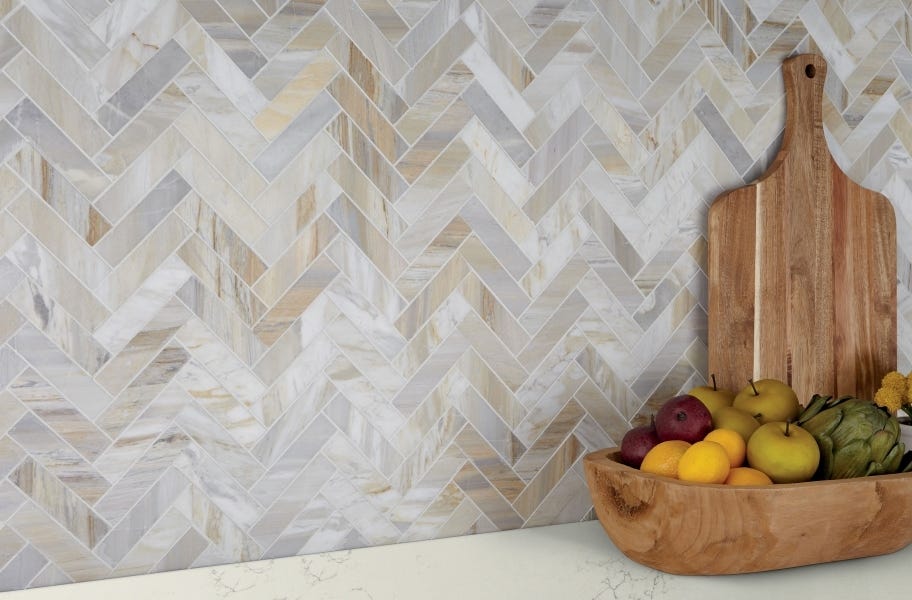
When you see the word “tile,” you might think that it only means porcelain or ceramic tile, but with backsplashes, there are way more options than that. You have a lot of materials to choose from that can affect the look and feel of your space. Some are more time-honored and practical, while others are modern and trendy.
Discover which type of tile is best for you.
Porcelain and Ceramic
Porcelain and ceramic tiles are pretty similar, the main difference being that porcelain is a special type of ceramic. Both options are made from a majority clay, mineral, and water solution that is then pressed into a tile shape and fired in a kiln at a high temperature.
The difference is that porcelain will be made from a denser kind of clay, which makes it less porous and more durable. The tiles are then glazed and fired again to remove any remaining moisture. This process makes the tiles incredibly durable, scratch-resistant, and waterproof.
Long story short, these are some of the most reliable tile options on the market. These days, you can find ceramic and porcelain mosaic tiles in endless shapes, colors, and sizes. They can look like anything, and that means they can always keep up with the latest styles.
Stone
Natural stone is highly sought-after for its beautiful naturally occurring patterns. With a huge variety of colors and textures to choose from, there is certain to be a genuine stone floor for your luxury interior design needs.
Some of the more popular stone tile options right now include travertine, limestone, and marble. They come at a higher price-point than stone-look tiles that only copy the real thing, but it can be worth it to have genuine material.
Keep in mind that real stone tile requires some special maintenance to make sure it stays its beautiful self. Because stone is porous, it can absorb moisture. It requires certain kinds of sealants and cleaning products to prevent unsightly discoloration.
Glass
A popular option for mosaics and backsplashes, glass tiles are incredibly versatile and waterproof. The thin pieces of glass are typically fixed to mesh backing sheets to create patterned mosaics.
Glass tiles come with a lot of style options in terms of color, finish, texture, and transparency. Whether you want something translucent or opaque, glossy or frosted, smooth or textured, there’s an option for you.
In the past, a glass mosaic could cost quite a lot, and it was seen as a luxury. These days, with easy to install, pre-assembled sheets, glass backsplash tile is accessible to everyone. If you want a modern kitchen, installing a glass mosaic is one of the easiest ways to get that look.
Metal
Metal tiles aren’t generally made of solid metal, but instead feature a resin core with a real metal surface. This makes the tile lighter and cheaper, so it’s a win-win! That metal covering can be made from copper, tin, aluminum, and even stainless steel.
A metal backsplash is an eye-catching addition to your space, offering a luxurious and almost futuristic look. Metallic tile pairs perfectly with geometric patterns, industrial and warehouse styles, and even more glitzy, glamorous aesthetics.
Because metal is so tough, you can expect the tiles to be durable as well as stylish, and they’re pretty easy to take care of.
Backsplash Tile Construction

Now you know that backsplash tiles can be made from a variety of materials, including porcelain, stone, glass, and even metal. These tiles are typically arranged into pre-made patterned sheets with durable fiberglass or paper mesh backings that hold them together. These are called mesh-mounted mosaics or mosaic sheets.
The mesh construction lets you achieve highly detailed mosaics without a lot of painstaking work. They’re easy to install and will hold together as you apply the tile to your backsplash. The sheets themselves are designed to fit together, so installation is kind of like putting a puzzle together.
Backsplash Tile Pros and Cons
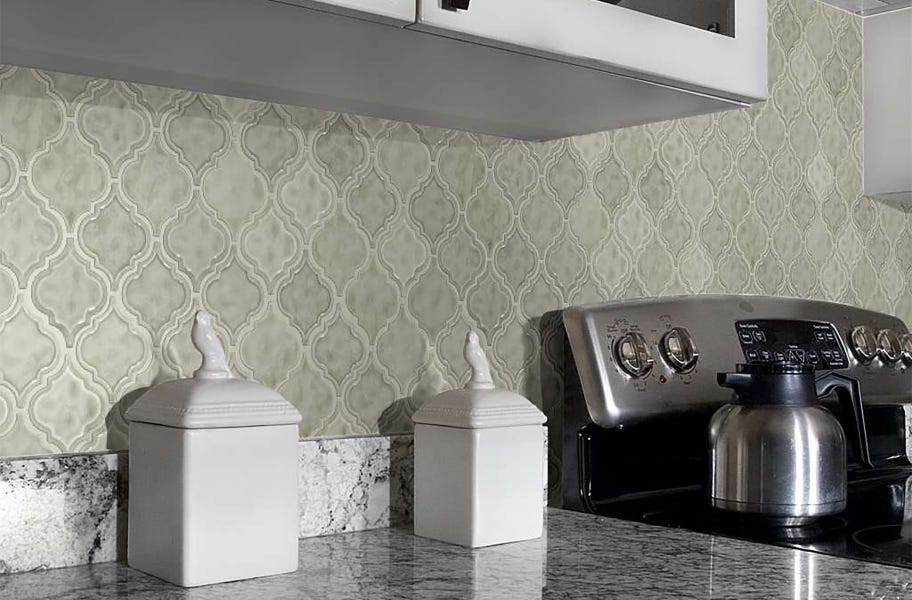
What are the advantages of backsplash tile?
- Waterproof/resistant: It will protect your walls from stains and water damage without absorbing any moisture or stains.
- Stylish: Basically any color, shape, or style you can think of is available to you with tile. You can always find something trendy, so your imagination is the limit.
- Durable: Tile is tough, and it stands up to the wear and tear of a busy kitchen or bathroom. Porcelain is especially durable and scratch-resistant.
- Easy DIY options: Some backsplash tiles are designed to be grout-free or even peel and stick. That way you save time and money on your installation.
What are the disadvantages of backsplash tile?
- Price: This isn’t the cheapest wall covering out there. Tile is more expensive than paint, but it’s also more versatile, durable, and water-resistant. There’s also a pretty wide range in prices between different types of tile. Even if you have a tight budget, you should be able to find an option that works for you.
- Traditional installation: It can be tricky to install regular backsplash tile without the easy DIY features, but that doesn’t mean it’s impossible!
| Related Content >> Grout FAQ |
Backsplash Tile Styles

Now that you understand how essential tile is for a functional bathroom or kitchen, it’s time to talk about the fun side of things: the style!
Looks
- Stone-look: People love the look of stone because it’s timeless and versatile. You can enjoy the raw, rustic beauty of nature or a more elegant luxury look, all without the price tag of real stone.
- Metallic-look: With metallic looks, you can give your kitchen an extra wow factor. This style is great for modern design.
- Concrete-look: Concrete-look tile is perfect for industrial or warehouse-style kitchens. It’s minimalist, contemporary, and oh-so chic.
- Decorative: Deck out your space with abstract shapes and patterns for a unique look with personality. These highly detailed decorative tiles are growing in popularity.
- Encaustic-look: The encaustic-look tile trend offers detailed, vintage patterns that resemble the handmade encaustic tiles of the past.
Shapes
- Hexagon: As one of the most popular tile shapes on the market, the hexagon shows no signs of fading out of style. It’s perfect for both modern and retro looks.
- Square: Traditional square tiles are a staple of design, not just because they’re so minimal and simplistic, but also because they can be versatile and patterned.
- Picket: Some people consider the picket tile shape to be the more contemporary alternative to subway tile. It’s trendy and geometric and perfect for modern spaces.
- Arabesque: For an elegant and highly detailed look, nothing beats the arabesque. This curvy, uniquely shaped tile brings tons of personality to the backsplash.
- Subway tile: These rectangular tiles may seem simple, but subway tiles are incredibly popular, allowing you to experiment with patterns and colors.
Patterns
- Herringbone: The herringbone pattern has taken over as one of the most popular ways to use subway tile. It’s intricate and versatile enough to work with a number of styles.
- Chevron: Chevrons are similar to the herringbone pattern but more angular. This is a highly geometric and modern look.
- Grid: A traditional grid pattern is perfect for modern or minimalist backsplashes that focus on simplicity. Many highly decorative tiles, like encaustic-look tiles, are best suited in a grid pattern.
| Related Content >> Tile Backsplash Trends |
How to Install Backsplash Tile
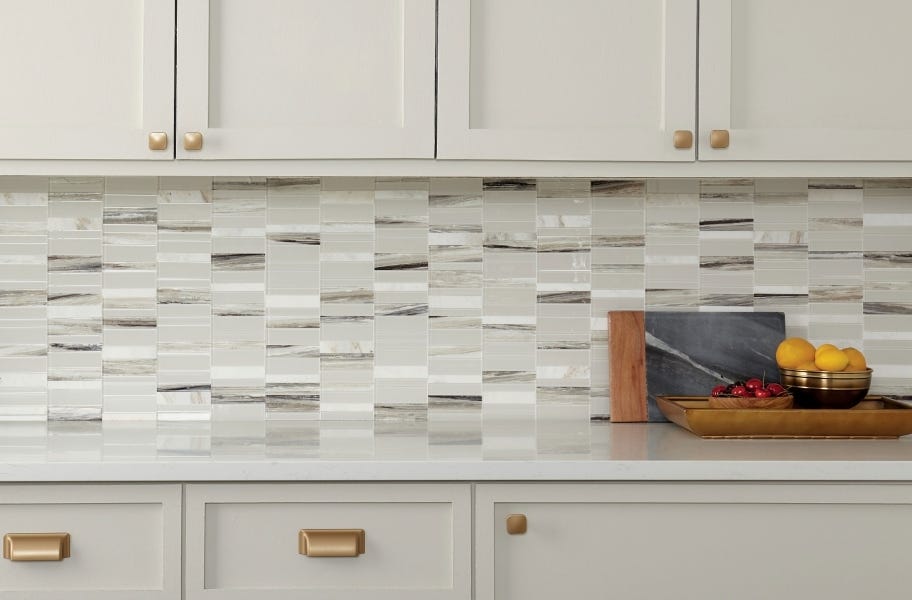
There’s more than one way to install tile, and some options are easier than others. Discover three methods of installing a backsplash to decide which kind of tile will work best for you.
Peel and Stick Installation
- The center of the tile sheet should align with the center mark you make on the wall. Partially peel away the backing from the first mosaic sheet and press it in place. Once you’re sure it’s aligned properly, remove the rest of the backing and firmly press it onto the wall.
- Continue applying tile sheets, leaving a 1/8" gap between the tile and the edges of the counter, cabinets, and any other surfaces.
- Make sure all tiles are aligned before sticking them to the wall. If you make a mistake and try to remove the tile after firmly pressing it to the wall, you may cause damage to the surface.
- Once all tiles are applied, seal up the edges with caulk.
- Protect the tile from water by applying a stone sealer as recommended by the manufacturer.
Standard Installation
- Mix the mortar according to the manufacturer’s instructions. Apply the mortar in a small area using the flat side of a notched trowel, and then comb it using the notched side. Apply it in small sections at a time so it doesn’t dry out before you apply the tile.
- Place the tiles or mosaic sheets along the wall, pressing firmly into the mortar. If you are using single tiles, insert spacers to keep everything evenly aligned.
- Once all tiles are installed, ensure that the surface is clean and level, and no mortar is drying on the face of the tiles.
- Allow the mortar to dry as recommended on the packaging. This could take anywhere from 24 to 72 hours.
- Remove any tile spacers. Mix the tile grout following the manufacturer’s instructions. Apply it to the tile joints using a rubber grout float. Press the grout into the tile joints at a 45-degree angle and work diagonally so you don’t drag out the grout as you work.
- Once finished, scrape away any excess grout. Use a damp sponge to clean the tiles and to smooth out the grout joints. Then wait a few more hours to wipe down the tile for a final time, removing the grout haze that might have formed on the surface.
- Seal the grout, and the tile if it is recommended. This will protect the backsplash from water and prevent mold or mildew.
- Apply latex caulk between the backsplash and the counter to completely seal the area.
Grout-Free Installation
- Follow the manufacturer’s instructions to mix the mortar. Use a notched trowel to smooth a small amount over the wall, and then comb it with the notched side of the trowel. It’s a good idea to add mortar a small amount at a time, so it doesn’t dry out too quickly.
- Firmly press the tile sheets into the mortar, making sure it’s even and aligned as you do so.
- Finish installing all tiles, and then check to make sure the surface is level. Clean any mortar that might be on the tiles, before it has a chance to dry.
- This is a grout-free tile, so obviously grouting is not required! However, if you still really want to use grout, you still can. It can be used to cover gaps in between sheets. If you choose to apply grout, do it with a grout bag.
- Use caulk to seal up the gaps between the tile and the counter.
| Related Content >> How to Install Backsplash Tile |
Cleaning and Maintaining Backsplash Tile

Cleaning your backsplash tile is just like cleaning floor tile, minus the sweeping and mopping part, obviously. Here are a few helpful tips and tricks to keep your backsplash looking sparkly clean.
Best Backsplash Tile Cleaners
The right cleaning product for your tile depends on the material. Even if you follow the right steps to clean your backsplash, you could damage the tile if your cleaner contains a harmful ingredient.
- Natural stone tile: Natural stone is porous, meaning it can soak up moisture and become discolored if you don’t use the right cleaning product. Avoid any products that contain lemon, vinegar, or other acids. Acidic cleaners cause yellowing in natural stone. When in doubt, look for a cleaning product that’s specifically made for natural stone.
- Porcelain and ceramic tile: A mild soap and water mixture is suitable. Always choose a concentrated pH-neutral cleaning product that is compatible with both the tile and the grout. Never use harsh chemicals with acids or ammonia, and they can cause damage.
- Glass tile: For the most part, you can treat glass tiles like any other glass surface. A mild water and vinegar mixture can clean the tile and leave it with a nice, glossy shine.
- Metal tile: Avoid solutions with acid or bleach, as well as oil-based or wax-based cleaners. Instead, clean metal surface tiles with a simple soap and water solution.
Please note: With any cleaner, it’s important to test it in an inconspicuous area to make sure it doesn’t cause any damage or discoloration.
How to Clean Backsplash Tile
- Use a cleaning solution: Dilute your tile cleaner in warm water, if applicable. The ideal cleaning solution will depend on the type of tile. Check with the tile manufacturer to confirm if a cleaning solution is compatible.
- Scrub the tile: Use a sponge that is damp, but not dripping. Gently scrub in a circular motion. Be thorough, so you don’t miss any stubborn stains.
- Refresh the sponge: You can’t clean tile with a dirty sponge! Regularly wring it out and refresh it with clean water.
- Dry the tile: Use a clean cloth, preferably microfiber, to dry the tile immediately after washing. This will prevent water spots.
- Clean the grout: As a final touch, get rid of any grime still hiding in the grout lines. Use dish soap or a mixture of water and baking soda. Gently scrub with a soft-bristled brush like a toothbrush until the grout is clean. To prevent dirt and grout stains in the future, it’s recommended that you regularly seal your grout from moisture.
| Related Content >> How to Clean Tile Floors |
Why Choose Backsplash Tile?
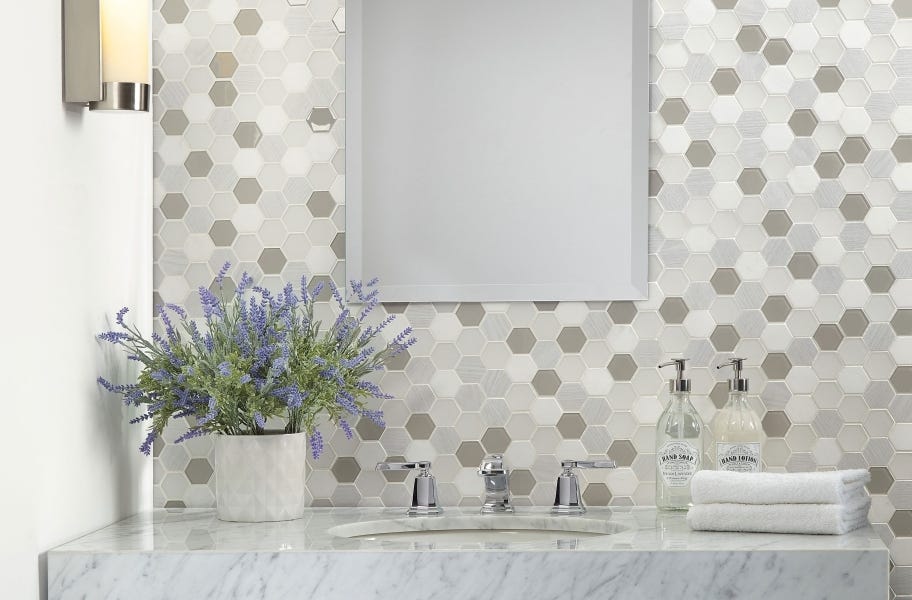
Still not sure if tile is perfect for you? No worries! Here’s a quick round-up of all the reasons to love backsplash tile.
- Style: Nothing beats the style options of tile. You get to choose the shape, color, pattern, and material to completely customize the look of your backsplash. You just can’t compare that to plain paint.
- Increases home value: It’s no secret that tile is more expensive than just paint, but that comes with the benefit of increased home value. It’s going to last longer and look great while doing it, making it the perfect addition during a renovation project.
- Easy DIY Options: It’s true that tile has a reputation for being tricky to install, but these days there are so many DIY-friendly ways to install backsplash tile. From peel and stick tile to grout-free options, there’s something out there that will work for you.
- Durable: Tile isn’t going to easily scratch, scuff, or chip, even in the most hectic kitchens. That means it will last longer and look great for years to come.
- Protects walls: Let’s be honest, the wall behind your sink can face some tough challenges, with splashes creating the possibility of water damage over the long term. With water-resistant tile, your walls are protected against splashes and moisture.
- Easy to clean: Tile won’t absorb stains, so as you have to do it wipe it down to keep it looking great.
Conclusion
Now that you’re an expert on backsplash tile, it’s time to explore your options!


